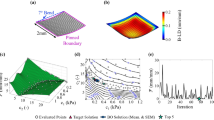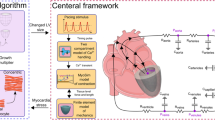Abstract
The initiation of a reentrant circuit requires a zone of slow conduction and a zone of unidirectional block. This study used computer model conditions under which partial coupling between segments of cardiac Purkinje tissue resulted in unidirectional block. The structure used was one-dimensional and divided into three segments: a middle segment of variable length coupled to two long (semi-infinite in concept) segments. The DiFrancesco-Noble equations represented the ionic currents of the membrane. The results show that the possibility of unidirectional block depends on the size of the middle segment and the coupling resistances between the segments. No combination of coupling resistances allowed unidirectional block for middle segments with a length of two space constants (4 mm) or longer. Unidirectional block occurred for many combinations of coupling resistances as the length of the middle segment decreased to around half a space constant (1 mm). The number of length combinations that caused unidirectional block decreased again as segment length further decreased. These results provide a possible mechanism of unidirectional block for situations where islands of viable tissue are connected through nonviable tissue, such as in a healed myocardial infarction.
Similar content being viewed by others
References
Allessie, M.A.; Bonke, F.I.M.; Schopman, F.J.G. Circus movement in rabbit atrial muscle as a mechanism of tachycardia. II. The role of nonuniform recovery of excitability in the occurrence of unidirectional block, as studied with multiple microelectrodes. Circ. Res. 39:168–177; 1976.
Cabo, C.; Barr, R.C. Propagation model using the DiFrancesco-Noble equations: Comparison to reported experimental results. Med. Biol. Eng. Comp. 30:292–302; 1992.
Cabo, C.; Barr, R.C. Reflection after delayed excitation in a computer model of a single fiber. Circ. Res. 71:260–270; 1992.
Chapman, R.A.; Fry, C.H. An analysis of the cable properties of frog ventricular myocardium. J. Physiol. 283:263–282; 1978.
Cranefield, P.F. The conduction of the cardiac impulse. Mount Kisco, NY: Futura Publishing Company, Inc; 1975.
Cranefield, P.F.; Klein, H.O.; Hoffman, B.F. Conduction of the cardiac impulse. I. Delay, block, and one-way block in depressed Purkinje fibers. Circ. Res. 28:199–219; 1971.
Cranefield, P.F.; Wit, A.L.; Hoffman, B.F. Genesis of cardiac arrhythmias. Circulation 47:190–204; 1973.
DiFrancesco, D.; Noble, D. A model of cardiac electrical activity incorporating ionic pumps and concentration changes. Phil. Trans. R. Soc. B307:353–398; 1985.
Downar, E.; Waxman, M.B. Depressed conduction and unidirectional block in Purkinje fibers. In: Wellens, H.J.J.; Lie, K.I.; Janse, M.J., eds. The conduction system of the heart. Philadelphia: Lea & Febiger; 1976: pp. 393–409.
Fenoglio, J.J., Jr.; Pham, T.D.; Harken, A.H.; Horowitz, L.N.; Josephson, M.E.; Wit, A.L. Recurrent sustained ventricular tachycardia: Structure and ultrastructure of subendocardial regions in which tachycardia originates. Circulation 68:518–533; 1983.
Fozzard, H.A. Membrane capacity of the cardiac Purkinje fibre. J. Physiol. 182:255–267; 1966.
Fozzard, H.A. Conduction of the action potential. In: Berne, R.M.; Sperelakis, N.; Geiger, S.R., eds. Handbook of physiology: The cardiovascular system. Bethesda, MD: American Physiological Society; 1979: pp 335–356.
Fozzard, H.A.; Schoenberg, M. Strength-duration curves in cardiac purkinje fibres: Effects of liminal length and charge distribution. J. Physiol. 226:593–618; 1972.
Freygang, W.H.; Trautwein, W. The structural implications of the linear electrical properties of cardiac Purkinje strands. J. Gen. Physiol. 55:524–547; 1970.
Friedman, P.L.; Fenoglio, J.J., Jr.; Wit, A.L. Time course for reversal of electrophysiological and ultrastructural abnormalities in subendocardial Purkinje fibers surviving extensive myocardial infarction in dogs. Circ. Res. 36:127–144; 1975.
Friedman, P.L.; Stewart, J.R.; Fenoglio, J.J., Jr.; Wit, A.L. Survival of subendocardial Purkinje fibers after extensive myocardial infarctions in dogs.In vitro andin vivo correlations. Circ. Res. 33:597–611; 1973.
Friedman, P.L.; Stewart, J.R.; Wit, A.L. Spontaneous and induced cardiac arrhythmias in subendocardial Purkinje fibers surviving extensive myocardial infarction in dogs. Circ. Res. 33:612–626; 1973.
Gardner, P.I.; Ursell, P.C.; Fenoglio, J.J., Jr.; Wit, A.L. Electrophysiologic and anatomic basis for fractionated electrograms recorded from healed myocardial infarcts. Circulation 72:596–611; 1985.
Han, J.; Moe, G.K. Nonuniform recovery of excitability in ventricular muscle. Circ. Res. 14:44–60; 1964.
Henriquez, C.S.; Plonsey, R. Effect of resistive discontinuities on waveshape and velocity in a single fiber. Med. Biol. Eng. Comp. 25:428–438; 1987.
Heppner, D.B.; Plonsey, R. Simulation of electrical interaction of cardiac cells. Biophys. J. 10:1057–1075; 1970.
Jack, J.J.B.; Noble, D.; Tsien, R.W. Electric current flow in excitable cells. Oxford, UK: Clarendon; 1975.
Jalife, J.; Moe, G.K. Excitation, conduction, and reflection of impulses in isolated bovine and canine Purkinje fibers. Circ. Res. 49:233–247; 1981.
Janse, M.J. Reentry rhythms. In: Fozzard, H.A.; Haber, E.; Jennings, R.B. eds. The heart and cardiovascular system. New York: Raven Press; 1986: pp. 1203–1238.
Janse, M.J.; Wit, A.L. Electrophysiological mechanisms of ventricular arrhythmias resulting from myocardial ischemia and infarction. Physiol. Rev. 69:1049–1169; 1989.
Josephson, M.E.; Harken, A.H.; Horowitz, L.N. Endocardial excision: A new surgical technique for the treatment of recurrent ventricular tachycardia. Circulation 60:1430–1439; 1979.
Josephson, M.E.; Horowitz, L.N.; Farshidi, A.; Spear, J.F.; Kastor, J.A.; Moore, E.N. Recurrent sustained ventricular tachycardia. 2. Endocardial mapping. Circulation 57:440–447; 1978.
Joyner, R.W. Mechanisms of unidirectional block in cardiac tissues. Biophys. J. 35:113–125; 1981.
Joyner, R.W.; Overholt, E.D.; Ramza, B.; Veenstra, R.D. Propagation through electrically coupled cells: two inhomogeneously coupled cardiac tissue layers. Am. J. Physiol. 247:H596-H609; 1984.
Joyner, R.W.; Picote, J.; Veenstra, R.; Rawling, D. Propagation through electrically coupled cells. Effects of regional changes in membrane properties. Circ. Res. 53:526–534; 1983.
Joyner, R.W.; Veenstra, R.; Rawling, D.; Chorro, A. Propagation through electrically coupled cells. Effects of a resistive barrier. Biophys. J. 45:1017–1025; 1984.
Kienzle, M.G.; Tan, R.C.; Ramza, B.M.; Young, M.-L.; Joyner, R.W. Alterations in endocardial activation of the canine papillary muscle early and late after myocardial infarction. Circulation 76:860–874; 1987.
Kleber, A.G., Riegger, C.B.; Janse, M.J. Electrical uncoupling and increase of extracellular resistance after induction of ischemia in isolated, arterially perfused rabbit papillary muscle. Circ. Res. 61:271–279; 1987.
la Fuente, D.; Sasyniuk, B.; Moe, G.K. Conduction through a narrow isthmus in isolated canine atrial tissue. A model of the W-P-W syndrome. Circulation 44:803–809; 1971.
Lazzara, R.; El-Sherif, N.; Scherlag, B.J. Electrophysiological properties of canine Purkinje cells in one-day myocardial infarction. Circ. Res. 33:722–734; 1973.
Lazzara, R.; El-Sherif, N.; Scherlag, B.J. Early and late effects of coronary artery occlusion on canine Purkinje fibers. Circ. Res. 35:391–399; 1974.
Lesh, M.D.; Anacker, S.; Goel, A. Fractal uncoupling, disparate activation and fractionated electrograms in a model of nonuniform anisotropy. Circulation 84:II-669; 1991 (abstract).
Loewenstein, W.R. Junctional intercellular communication: The cell-to-cell membrane channel. Physiol. Rev. 61:829–913; 1981.
Mendez, C.; Mueller, W.J.; Merideth, J.; Moe, G.K. Interaction of transmembrane potentials in canine Purkinje fibers and at fiber-muscle junctions. Circ. Res. 24:361–372; 1969.
Mendez, C.; Mueller, W.J.; Urguiaga, X. Propagation of impulses across the Purkinje fiber-muscle junctions in the dog heart. Circ. Res. 26:135–150; 1970.
Michelson, E.L.; Spear, J.F.; Moore, E.N. Initiation of sustained ventricular tachyarrhythmias in a canine model of chronic myocardial infarction: importance of the site of stimulation. Circulation 63:776–784; 1981.
Mines, G.R. On dynamic equilibrium in the heart. J. Physiol. 46:349–382; 1913.
Overholt, E.D.; Ioyner, R.W.; Veenstra, R.D.; Rawling, D.; Wiedmann, R. Unidirectional block between Purkinje and ventricular layers of papillary muscles. Am. J. Physiol. 247:H584-H595; 1984.
Plonsey, R.; Barr, R.C. Interstitial potentials and their change with depth into cardiac tissue. Biophys. J. 51:547–555; 1987.
Plonsey, R.; Barr, R.C. Bioelectricity: A quantitative approach. New York: Plenum Press; 1988.
Plonsey, R.; Henriquez, C.S.; Trayanova, N. Extracellular (volume conductor) effect on adjoining cardiac muscle electrophysiology. Med. Biol. Eng. Comp. 26:126–129; 1988.
Quan, W.; Rudy, Y. Unidirectional block and reentry of cardiac excitation: A model study. Circ. Res. 66:367–382; 1990.
Rudy, Y.; Quan, W. A model study of the effects of the discrete cellular structure on electrical propagation in cardiac tissue. Circ. Res. 61:815–823; 1987.
Rudy, Y.; Quan, W. Propagation delays across cardiac gap junctions and their reflection in extracellular potentials: a simulation study. J. Cardiovasc. Electrophysiol. 2:299–315; 1991.
Schmitt, F.O.; Erlanger, J. Directional differences in the conduction of the impulse through heart muscle and their possible relation to extrasystolic and fibrillary contractions. Am. J. Physiol. 87:326–347; 1928.
Spach, M.S. The discontinuous nature of electrical propagation in cardiac muscle. Consideration of a quantitative model incorporating the membrane jonic properties and structural complexities (ALZA lecture). Ann. Biomed. Eng. 11:209–261; 1983.
Spach, M.S.; Kootsey, J.M. The nature of electrical propagation in cardiac muscle. Am. J. Physiol. 244:H3-H22; 1982.
Spach, M.S.; Miller, W.T., III; Dolber, P.C.; Kootsey, J.M.; Sommer, J.R.; Mosher, C.E., Jr. The functional role of structural complexities in the propagation of depolarization in the atrium of the dog. Cardiac conduction disturbances due to discontinuities of effective axial resistivity. Circ. Res. 50:175–191; 1982.
Spach, M.S.; Miller, W.T., III; Geselowitz, D.B.; Barr, R.C.; Kootsey, J.M.; Johnson, E.A. The discontinuous nature of propagation in normal canine cardiac muscle. Evidence of recurrent discontinuities of intracellular resistance that affect the membrane currents. Circ. Res. 48:39–54; 1981.
Spear, J.F.; Michelson, E.L.; Moore, E.N. Cellular electrophysiologic characteristics of chronically infarcted myocardium in dogs susceptible to sustained ventricular tachyarrhythmias. J. Am. Coll. Cardiol. 1:1099–1110; 1983.
Spear, J.F.; Michelson, E.L.; Moore, E.N. Reduced space constant in slowly conducting regions of chronically infarcted canine myocardium. Circ. Res. 53:176–185; 1983.
van Capelle, F.J.L.; Durrer, D. Computer simulation of arrhythmias in a network of coupled excitable elements. Circ. Res. 47:454–466; 1980.
van Capelle, F.J.L.; Janse, M.J. Influence of geometry on the shape of the propagated action potential. In: Wellens, H.J.J.; Lie, K.I.; Janse, M.J., eds. The conduction system of the heart. Philadelphia: Lea & Febiger; 1976; pp. 316–335.
Watanabe, Y. Reassessment of parasystole. Am. Heart J. 81:451–466; 1971.
Weingart, R. Electrical properties of the nexal membrane studied in rat ventricular cell pairs. J. Physiol. 370:267–284; 1986.
Wennemark, J.R.; Ruesta, V.J.; Brody, D.A. Microelectrode study of delayed conduction in the canine right bundle branch. Circ. Res. 23:753–769; 1968.
Author information
Authors and Affiliations
Rights and permissions
About this article
Cite this article
Cabo, C., Barr, R.C. Unidirectional block in a computer model of partially coupled segments of cardiac Purkinje tissue. Ann Biomed Eng 21, 633–644 (1993). https://doi.org/10.1007/BF02368643
Issue Date:
DOI: https://doi.org/10.1007/BF02368643




